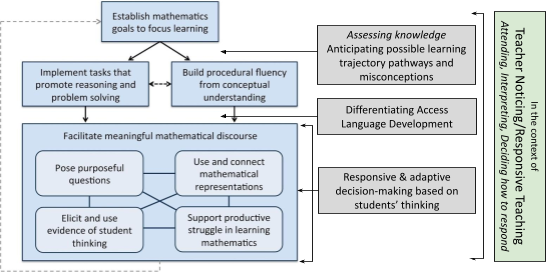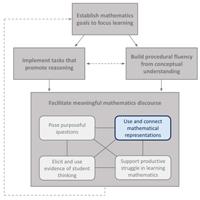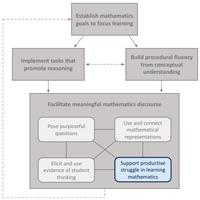Cluster Two: Instruction (Attending, Interpreting, Responding)
Return to the Mathematical Practices Overview Page
A Professional Development Approach
- Facilitate meaningful mathematical discourse (MP3: Construct viable arguments and critique the reasoning of others)
- Pose purposeful questions
- Elicit and use student thinking
- Use and connect mathematical representations (MP4: Model with mathematics; MP5: Use appropriate tools strategically.)
- Support productive struggle in learning mathematics (MP1: Make sense of problems and persevere in solving them; MP5: Use appropriate tools strategically.)
Introduction
Mathematical goals and objectives have been targeted. There is a sense of the different pathways students may progress through, and the mathematical tasks and misconceptions that need to be addressed, have been identified. Enacting the lesson with a responsive teaching approach centers the instruction around students’ thinking. There are stages to the instruction: Posing and unpacking the task before work begins by eliciting students’ initial thoughts. Engaging in the task commences. Sharing and connecting strategies between and among students occurs both during the work among the students themselves and as you move through the space engaging in one-on-one and small group conversations. Additionally, sharing and connecting occurs during the public sharing when commonalities and variations of strategies, as well as efficiencies are explored. Responsive teaching is based on attending to the substance of students’ ideas, recognizing and interpreting important mathematical connections within those ideas, and deciding how to take up and pursue those ideas. That mindset becomes the focus of your instructional moves (Richards & Robertson, 2016, Jacobs, et al, 2010, Vilson, 2017).
This is where making in-the-moment decisions with the mathematical goals of the lesson in mind shifts the pre-planned intentions.
- Which mathematical ideas to pursue?
- Which strategies to have students elaborate on and clarify?
- When to stop mid-stream and have interim sharing to explore partial ideas and/or redirect student strategies?
- Which sequence of strategies should be publicly shared?
- What strategies should be compared and contrasted to draw out efficiencies or differing underlying mathematical approaches? etc.
These are all the decisions one must make in-the-moment. These are points of instructional decision making which cannot be prescribed in a lesson plan. They become instructional habits of mind, the teacher noticing skills that develop with support over time as one shifts from predominantly telling students how to solve mathematical tasks (I do. We do. You do.) to being responsive around student thinking (Pose ←→ Elicit ←→ Engage ←→ Share & Connect). Or as one teacher describes it, You do ←→ We do ←→ I do (Waddell, 2018).
Central to this instructional approach is learning how to conduct and facilitate mathematical conversations in these language-rich learning environments. Liljedahl (2015) describes a thinking classroom as…
"...a classroom that is not only conducive to thinking but also occasions thinking, a space that is inhabited by thinking individuals as well as individuals thinking collectively, learning together, and constructing knowledge and understanding through activity and discussion." (p.2)
This aspect of the system of practice is where the practices outlined in the Mathematics Teaching Framework (NCTM, 2017) manifest themselves requiring a nimbleness on the part of the teacher to respond to the work unfolding within the learning community.

Figure One: A System of Practice, System of Instruction (Heibert, et al. 1997), Mathematics Teaching Framework (NCTM, Taking Action Series, 2017), Teacher Noticing Skills/Responsive Teaching (Jacobs, et al., 2010, Richards & Robertson, 2016)
Implementing tasks that promote reasoning and problem-solving
Tasks can be simple or complex. (See Cluster 1: Planning and Assessment) There may be a single answer, yet many strategies by which the task can be solved. (See Cluster 4: Differentiation) Some tasks require a shorter or longer duration of time. Math Talks are designed to be concise where multi-step rich tasks require time to process and solve. The commonality is in the implementation of the tasks. There is an emphasis on students’ publicly collaborating and sharing with their peers to articulate how the problem was solved and comparing and contrasting strategies regarding the mathematical underpinnings and generalizability of the approach. These learning spaces are thinking, language-rich spaces.
Facilitating meaningful mathematical discourse
Mathematics is socially constructed, meaning, the solutions to various problems require a level of justification and proof that forms a consensus as to the veracity of the work. Language of symbols and the precision of spoken and written words all are required. A great mind may think great thoughts but until it is justified and proven to others, it remains unsubstantiated.
There are different approaches to the facilitation of mathematical conversations. There are common elements among those that influence student achievement (Hiebert, et al., 1997):
- Nature of the instructional tasks (Cluster One: Planning & Assessment)
- Social cultural classroom norms
- Physical environment of the learning community
- Role of the teacher
- Language and social interactions
- Equity & accessibility
Posing purposeful questions – Elicit & use student thinking
The type of questions and prompts posed and the timing of those can move (or halter) the flow of a lesson. Questions are intended to draw out students’ thinking in order to have them reflect, clarify or elaborate on their processing. The point of teacher questions and prompts is to elicit student thinking, therefore allowing you to attend to and interpret the nature of their mathematical understanding (formative assessment) and subsequently deciding how to respond instructionally.
Posing questions and prompts needs to be a consistent experience and expectation within the classroom norms. In many classrooms, being asked a question means something is wrong. Students, regardless of age, will often start quickly changing their answers. It needs to be clearly established at the beginning of the school year that you are interested in their thinking whether or not they have the correct answer. Therefore, it is imperative that all students expect to be able to explain their thinking and to justify that thinking with evidence.
Read more about types and timing of questions and prompts
Examples of Classroom Conversations
- Math Talks/Mental Math – A Third Grade Division Task
- Unpacking a lesson & Interim Sharing – A Fifth Grade Volume Task
- Thinking Classroom – A Middle School/High School Classroom
Use and Connect Mathematical Representations (Page 24, Principles to Action, NCTM, 2014)

Capturing mathematical ideas through the use of various models results in being able to consider and analyze the relationships and the procedural actions used to find a solution(s). Models capture the strategies used. Seeing the mathematics modeled in a variety of representational forms allows learners to consider the connections and relationships. It allows thinking to be extended, considered by others as the ideas are communicated publicly. The ability to flexibly move across representations is critical as each model displays the mathematical concepts differently allowing the full range of learners within the space to comprehend and connect important ideas.
Many representations are social conventions that have emerged over time to reflect the consensus of the mathematical community. Equations, graphs, and tables follow certain conventions. However, it is well documented that learners create their own mathematical ways of conveying their ideas that are quite inventive and powerful in conveying their thinking. As the classroom teacher, when and how to introduce certain mathematical representational conventions, along with attending to and interpreting student modeling, requires an intentionality that influences in deciding how to respond to students’ thinking.
Read more about the use and connecting of mathematical representations
Support Productive Struggle in Learning Mathematics (Page 48, Principles to Action, NCTM, 2014

Productive struggle is a necessary component for deeply learning mathematics and to think mathematically. It is an attribute of learning that many in the U.S., that both teachers and parents feel largely uncomfortable with seeing students deal with. Teachers are supposed to “help.” But does helping really look like? What is the difference between “productive struggling” and “frustration”? When does helping merely become pure telling instead elicitation? As stated in NCTM’s Principles to Actions,
|
Mathematics classrooms that embrace productive struggle necessitate rethinking on the part of both students and teachers. Students must rethink what it means to be a successful learner of mathematics, and teachers must rethink what it means to be an effective teacher of mathematics. (p. 49) |
Redefining Student and Teacher Success
NCTM Principles to Actions (2014, p. 46)
Adapted from Smith (2000, p. 382)
|
Expectations for Students |
Teacher Actions to support students |
Classroom-based indicators of success |
|
Most tasks that promote reasoning and problem solving take time to solve, and frustration may occur, but perseverance in the face of initial difficulty is important. |
Use tasks that promote reasoning and problem solving; explicitly encourage students to persevere; find ways to support students without removing all the challenges in a task. |
Students are engaged in the tasks and do not give up. The teacher supports students when they are “stuck” but does so in a way that keeps the thinking and reasoning at a high level. |
|
Correct solutions are important, but so is being able to explain and discuss how one thought about and solved particular tasks. |
Ask students to explain and justify how they solved a task. Value the quality of the explanation as much as the final solution. |
Students explain how they solved a task and provide mathematical justifications for their reasoning. |
|
Everyone has a responsibility and an obligation to make sense of mathematics by asking questions of peers and the teacher when he or she does not understand. |
Give students the opportunity to discuss and determine the validity and appropriateness of strategies and solutions. |
Students question and critique the reasoning of their peers and reflect on their own understanding. |
|
Diagrams, sketches, and hands-on materials are important tools to use in making sense of tasks. |
Give students access to tools that will support their thinking process. |
Students are able to use tools to solve tasks that they cannot solve without them. |
|
Communicating about one’s thinking during a task makes it possible for others to help that person make progress on the task. |
Ask students to explain their thinking and pose questions that are based on students’ reasoning, rather than on the way that the teacher is thinking about the task. |
Students explain their thinking about a task to their peers and the teacher. The teacher asks probing questions based on the students’ thinking. |
The conditions for both students and teachers to be comfortable with the idea and conditions for productive struggle circles back to the elements for Facilitating Meaningful Mathematical Discourse. It is all tied together.
- Nature of the instructional tasks (Cluster One: Planning & Assessment)
- Social cultural classroom norms
- Physical environment of the learning community
- Role of the teacher
- Language and social interactions
- Equity & accessibility
Read more about supporting productive struggle in learning mathematics.
Return to the Mathematical Practices Overview Page
References
Hiebert, J., Carpenter, T.P., Fennema, E., Fuson, K. C., Wearne, D., Murray, H. Olivier, A., and Human, P. (1997). Making sense: Teaching and learning mathematics with understanding. pp. 29-41. Heinemann Press: Portsmouth, NH.
Jacobs, V.R. and Empson, S.B., (2016), Responding to children’s mathematical thinking in the moment: An emerging framework of teaching moves. ZDM Mathematics Education 48:185–197.
Jacobs, V.R., Lamb, L.L.C., Phillipps, R.A. (2010) Professional Noticing of Children’s Mathematical Thinking. Journal for Research in Mathematics Education. 41(2), 169–202.
Liljedahl, P. (2015). Building thinking classrooms: Conditions for problem-solving. Retrieved from: https://peterliljedahl.com/wp-content/uploads/Building-Thinking-Classrooms-Feb-14-20151.pdf
National Council of Teachers of Mathematics (2017). Taking action: Implementing Effective Mathematics Teaching Practices. https://www.nctm.org/store/takingaction/ NCTM: Reston, VA.
Richards, J. and Richardson, A.D., (2015). A Review of the Research on Responsive Teaching. In A. D. Robertson, R. E. Scherr, and D. Hammer (Eds.) Science and Mathematics Responsive Teaching in Science and Mathematics (pp.36-55), Routledge, London.
Vilson, J.L. (2017). Math as activism. Retrieved from: https://www.teachingworks.org/resources/working-papers/
Waddell, K.J. (2018). You do, we do, I do: A strategy for productive struggle. Retrieved from: https://www.ascd.org/el/articles/you-do-we-do-i-do-a-strategy-for-productive-struggle
Search for a Framework
Search the Mathematics and Science Frameworks.
Begin your Search »
Feedback
We want your feedback! Tell us what's working, what's not, and how you are using these Frameworks.
Give us your Feedback »
